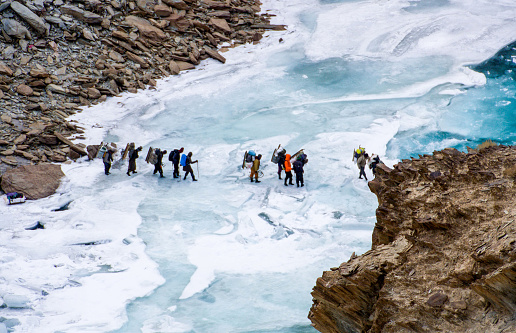Chadar Trek
-
Difficulty
Difficult -
Duration
8 Days -
Maximum Altitude
11,110 ft -
Pickup Point
Leh -
Best Time To visit
January
TREK PACKAGE
RS 30,000 + 5% GST
- 8 Days
- Trekking 62 Km
Pick Up Point: Leh
Payment Mode: Cash, UPI, Bank Transfer
Trek Info
- Region :- Ladakh (Leh)
- Snow: December to April
- Trekking Km: 62 Kms
Need Help?
Call us on 9045089649
- Overview
- About Trek
- Highlights
- Brief Itinerary
- Detailed Itinerary
- How To Reach
- Cost Terms
- Cancellation
- Things To Carry
- FAQs
- Risk & Respond
- Secure Travels Guidelines
Chadar Overview
Chadar Trek is said to be an inaccessible winter trek in the Zanskar Valley of the Ladakh region, which is in the Indian state of Jammu and Kashmir. The steep cliff walls of Zanskar Valley are found up to 600 meters in height and the Zanskar River (a tributary of the Indus River) is only 5 meters wide in some places. The Chadar Trek is the frozen Zanskar River, which provides access to the Zanskar Valley during winters for locals and tourists to use.
The place has been used by the local people for centuries as a trade route and is a fairly well-established trek.
About Chadar Tapovan Trek
December to February is the best time to go on the Chadar Trek. Most normal treks have an average temperature of 3 to 10 degrees Celsius, but the Chadar trek’s temperature will require you to keep yourself and your clothes tight for – 15 to – 20 degrees Celsius. Genuine moments, such as the sun’s brief appearances throughout the walk or the singing of songs around the bonfires, will elate you and help you discover a wonderful existence. The Chadar trek in Ladakh is a once-in-a-lifetime opportunity to trek across a spectacular landscape with practically clear ice sheets and gigantic yet breathtaking mountains. The trek invites you to have an out-of-this-world experience of awe, wonder, adventure, and the quest to overcome your fear.
Along with all the sightseeing options and meeting some locals to sample the best local cuisine, you might also get a chance to witness some lavish local celebrations like Ladakhi Losar, Matho Monastery festival, Thiksay Gustor, and Spituk Gustor if you’re lucky. With Ladakh’s abundance of surprises and gifts, you can stock up on brightly coloured indigenous attire for yourself and your special pals! Wouldn’t it be fantastic to put them on and relive your favorite memories of the Chadar Trek and Ladakh? But, despite all of Ladakh’s advantages over other places, don’t overlook your ‘THE’ moment — the Chadar Trek.
Trek Highlights

- Chadar Trek is an inaccessible winter trek in the Zanskar Valley of the Ladakh region, which is in the Indian state of Jammu and Kashmir. The cliff walls of Zanskar Valley are found up to 600 meters in height and the Zanskar River (a tributary of the Indus River) is only 5 meters wide in some places.
- The Chadar Trek is the frozen Zanskar River, which provides access to the Zanskar Valley during winter for locals and tourists.
- The local people have used the place for centuries as a trade route and is a fairly well-established trek.
Chadar Trek has been attracting tourists from all over the world for many years, it is one of the most exciting and challenging treks, covering a distance of about 105 km on foot, covering a distance of 15-17 km on average each day.
Brief Itinerary
Day 1: Reporting day at Leh
• Altitude 3,500m/11,400 ft.
• Keep your woolen cap and gloves handy at the Airport.
• Orientation & Briefing of the trek at noon (Mandatory).
• Check-in Hotel (10:00 am) (Centrally heated room).
• Bring a copy of your ID proof and 2 photographs. Foreigner, a copy of passport and visa.
• Network is available (only post-paid).
• ATM is available.
• Visit any very high altitude place or pass is not advisable.
• Consumption of alcohol and smoking is strictly prohibited.
• Spend the day in the room itself to acclimatize.
Day 2: Acclimatization Day
• Rest + Acclimatisation day.
• Sightseeing included in the cost (Hall of Fame, Shey Monastery, Thiksey Monastery).
• Visit any very high altitude place or pass is not advisable.
• Consumption of alcohol and smoking is strictly prohibited.
• Stay in a Hotel (Centrally heated room).
Day 3: Medical test day
• Wake up early and get ready for medical tests.
• Drive/Walk to the Government Medical camp.
• Get your Oxygen and BP reading (There is a long queue due to the rush of tourists. It may take 3-4 hours depending on the rush).
• Late afternoon insurance formalities.
• Enjoy an evening in Leh.
• Stay in a hotel.
Day 4: Leh to Shingra Koma then Trek to Tsomo Paldar
• Altitude 3,500m/11,400ft to 3,200m/10,400 ft.
• Breakfast at the hotel is included in the cost.
• Drive to Shingra Koma 70 km, 3-4 hrs.
• Trek 3km, 2 hrs.
• Gumboots are mandatory.
• Carry two thermos flasks of 1 liter each.
• Stay in tents.
• Drive through Gurudwara Pathar Sahib, Magnetic Hill, and the confluence of the Zanskar and Indus.
Day 5: Tsomo Paldar to Tibb Cave
• Altitude 3,200m/10,400 to 3,300m/10,800 ft.
• Trek 15 km, 6-7 hrs.
• Hot Lunch on the way.
• Make sure you fill your thermos with warm water before you leave.
• Pass through a waterfall that never freezes.
• You will only get sunshine around 9-10 am.
• Stay in a tent.
Day 6: Tibb Cave to Nerak
• Altitude 3,300m/10,800 ft to 3,400m/11,100 ft.
• Trek 13 km / 6-7 hrs.
• Hot Lunch on the way.
• Make sure you fill your thermos with warm water before you leave.
• Nerak is the first village of the Zanskar region.
• If we reach on time at Nerak camp, accordingly we can go to visit Nerak village.
• Attraction Frozen waterfall.
• Stay in a tent.
Day 7: Nerak – Tibb Cave
• Altitude 3,400m/11,100 ft to 3,300m/10,800 ft
• Trek 13 km / 5-6 hrs.
• Hot Lunch on the way.
• Make sure you fill your thermos with warm water before you leave.
• Stay in a tent.
Day 8: Tibb Cave to Shingra Koma then Drive to Leh
• Altitude 3,300m/10,800ft to 3,200m/10,400 ft.
• Trek to Shingra Koma 13 km/ 5-6 hours
• Drive to Leh 70 km/ 3-4 hours
• Hot Lunch on the way
• Make sure you fill your thermos with warm water before you leave
• You will reach Leh by the evening.
• Stay in a hotel (Centrally heated room) (Running hot water in taps).
Detailed Itinerary
Day 1: Day of reporting in Leh
You’ll arrive at the Leh airport. It’s crucial to keep your warmies on hand because the temperature will drop dramatically as soon as you get at the Leh airport. After arriving at the guesthouse, you will have ample opportunity to unwind and acclimate to the surroundings. Later in the evening, stop by the Leh market for some last-minute window shopping. The temperature can range from -10 to -15 degrees throughout the day from the end of January until the middle of February. It’s also critical to keep your body hydrated by increasing your beverage intake, which will aid in maintaining your body temperature.
Day 2: Day of Acclimatization
In light of the health issues that trekkers are experiencing (AMS), the new regulations require that anyone undertaking the Chadar Trek spend at least two days in Leh to adequately acclimate to the weather conditions. It is irreversible, and every trekker must follow it to the letter. You can spend the day touring the city’s attractions. You are also welcome to join us for a little sight-seeing tour . It lasts only 3-4 hours and covers all of Leh’s key attractions. It is best to avoid visiting sites that are at a greater elevation. Before heading to bed, double-check your essentials.
Day 3: The day of the medical checkup
The big day has here. This day will determine whether you continue or not. Get up early in order to arrive at the Medical Camp as soon as feasible. Despite the fact that exams take less time, they are delayed due to the tourist rush. We’ll handle any insurance formalities in the late afternoon. You will not be permitted to participate in the Chadar trip if the tests reveal that you are not physically fit. Please contact your Trek Coordinator for information on return procedures.
How To Reach
By Air: The nearest airport to Chadar Trek is Kushok Bakula Rimpochee Airport (IXL), located in Leh. This airport is connected to major international airports in India like Delhi, Mumbai, Chennai, etc.
By Train: Take the New Delhi Jammu Tawi Rajdhani Express, which leaves Delhi at 8:40 pm. and arrives in Jammu at 5:45 am. From Jammu you can take a bus to Srinagar, from Srinagar there are regular buses to Leh. It is recommended to fly from Delhi to Leh and rent a taxi to Chilling the next day after acclimatization.
By Road: Delhi to Leh is 1,266 km via the NH1. It is 64 km from Leh to Chilling. To get to the Chadar Trek, one has to go to Leh. From Leh, the journey begins and leads to the freezing Zanskar Rive.
Cost Terms
Addition
1. Accommodation
2. Reflections
3. Transportation
4. Sightseeing
5. All Permits
6. Trek Accoutrements like ( Canopies, Sleeping bags, touring, shoes, and mackintoshes)
7. Trek leader.
8. First Aid Kit
Exclusion
1. Particular Charges
2. Redundant food
3. Insurance
4. Medical Exigency
Cancellation Policy
Retractions before 25 days from the beginning of the Trip
Discount choices
- 100 percent cash voucher for the same excursion for one year
- 85% money voucher for any outing for one year
Retraction between 14 days and 10 days to the beginning of the Trip
- Book a similar trip, in a similar season, with some other bunch
- 80% money voucher for the same excursion for one year
- 70% money voucher for any outing for one year
Things To Carry
1) Comfortable Clothes
2) Great Trekking Shoes
3) Water Bottle
4) Clinical Kit
5) Track Pants
6) Parka and umbrella
7) Water Bottle
8) Light stuff
9) Warm Caps
10) Power bank
11) Sim Card
FAQs
The most difficult aspect of this walk is dealing with the freezing conditions day in and day out. On a bad day, the minimum temperature can reach -30 degrees Celsius. The average daytime temperature is around -18 degrees Celsius. On a sunny day, the difference between -5 and -18 degrees Celsius is hard to know. It is only when the winds pick up or your body part becomes wet that you realize how much colder it is. Temperatures in Leh range from -10 to -15 degrees Celsius.
On the Chadar Trek, the majority of the local porters wear gumboots, which are readily purchased in Leh. This appears to be the most practical and cost-effective method of ice walking. Many people walk the entire route in gumboots, although it is difficult to walk in them all the time since they are uncomfortable. We recommend that you wear waterproof boots. Quechua has some excellent trekking boots that are also suitable for Chadar.
Yes, you’ll need both a fleece and a down jacket… and they’ll have to be good ones! It’s chilly all over. When walking, you can usually get away with simply a fleece because your body generates enough heat. A nice down jacket is required once you arrive at Campsite and throughout the evenings.
To avoid freezing, drinking water must be kept sufficiently warm. In the mornings, you are usually provided hot water in your water bottles. To minimise freezing, keep this inside your day sack rather than in the side pocket. The purchase of a water bottle sleeve ensures that the bottle does not freeze. We also recommend that travelers bring a 1 liter Thermos bottle in addition to their standard bottles to keep the water warm and to have tea or warm juice on the path.
On the chadar, wood is rare and difficult to get by. In addition, the journey has become so famous that many groups visit Ladakh in the winter to complete it. That suggests there is a scarcity of timber. However, we shall build a fire wherever we can gather wood in the evenings.
Risk & Response
Altitude is a risk. Before you begin the trek, you should be aware of the effects of high altitude on your body. Acute Mountain Sickness (AMS) symptoms include a moderate headache, nausea, and overall discomfort.
Response: If you have any of these symptoms, notify the trek leader immediately and follow his advice. To deal with the scenario, each campsite contains a stretcher, a fully prepared first aid kit, and oxygen cylinders.
Weather Risk: No one can guarantee snow, rain, or sunlight, even if we keep a constant eye on the weather. Please keep in mind that your safety is our primary priority, and if the weather isn’t cooperating, we won’t leave the campsite.
Response: The choice to go or wait for better weather will be made solely by the Trek Leaders and Guides.
Risk: Injury is a possibility. While trekking across difficult terrains, minor injuries such as calf sprains, bruising, and other minor ailments are prevalent. Serious injuries, such as fractures or significant cuts, are quite uncommon.
Response: All of our Trek Leaders are trained in wilderness first aid. They’ve been taught to deal with emergencies and have well-stocked first-aid equipment to deal with minor injuries. In the event of major injuries, the patient is carried to the nearest roadhead on a stretcher and taken to the nearest medical facility.
Secure Travels Guidelines
DO’S AND DON’TS ON A TREK
1. Alcohols or any other intoxicating products ‘’STRICTLY PROHIBITED’’
during the trek.
2. Always pay heed to the trek guides or instructors.
3. Try not to leave the group under any circumstances.
4. Avoid trekking during the night as it is extremely dangerous.
5. Avoid using earphones as that might hinder your hearing.
6. Do not participate in or encourage littering of the places in any form.
7. While visiting the local villages and tourist sites, obey the local guidelines
and instructions.
8. Do not harm or interrupt the local sentiments of the places.
IMPORTANT:
Your safety is of paramount concern while traveling with Secure Travels.
Please note that your leader has the authority to amend or cancel any part of
the itinerary if it is deemed necessary due to safety concerns. Since adventure
entails traveling in remote mountainous regions, we cannot guarantee that we
will not deviate from it. Weather conditions, the health condition of a group
member, unexpected natural disasters, etc., can all contribute to changes in
the itinerary. The leader will try to ensure that the trip runs according to plan,
but please be prepared to be flexible if required.
Weather Forecast
The weather during April, May and June is mostly cool and pleasant but gets chilly and cold during winters.

Have any Query?
Call Us on 9045089649
-
Kedarkantha Trek
UttarakhandKedarkantha Trek DifficultyDifficult Duration 6 Days Maximum Altitude12,500 ft Base Camp Sankri (10 hrs drive from Dehradun) Best Time To visit April, May, Sep, Oct.
-
Bali Pass Trek
UttarakhandBali pass Trek DifficultyDifficult Duration 08 Days Maximum Altitude16,200 ft Base Camp Sankri Best Time To visit May, June, Mid Aug, Mid Oct Previous Next.
-
Ladak Bike Trip
Leh LadakLeh Ladakh Bike Trip DifficultyDifficult Duration 6 Days Maximum Altitude11,480 ft Base Camp Leh Best Time To visit April, May, Sep, Oct Previous Next TREK.
-
Kashmir Great Lakes
Jammu & KashmirKashmir Great Lakes Trek DifficultyModerate To Difficult Duration8 Days Maximum Altitude13,700 ft Base Camp Sonamarg Best Time To visit July, August Previous Next TREK PACKAGE.
